实验1
task1.cpp
点击查看代码
#include <iostream>
#include <string>
#include <vector>
#include <algorithm>
// 模板函数声明
template<typename T>
void output(const T &c);
void test1();
void test2();
void test3();
int main() {
std::cout << "测试1: \n";
test1();
std::cout << "\n测试2: \n";
test2();
std::cout << "\n测试3: \n";
test3();
}
// 输出容器对象c中的元素
template <typename T>
void output(const T &c) {
for(auto &i : c)
std::cout << i << ' ';
std::cout << '\n';
}
// 测试1:组合使用算法库、迭代器、string反转字符串
void test1() {
using namespace std;
string s0{"0123456789"};
cout << "s0 = " << s0 << endl;
string s1(s0);
// 反转s1自身
reverse(s1.begin(), s1.end());
cout << "s1 = " << s1 << endl;
string s2(s0.size(), ' ');
// 将s0反转后结果拷贝到s2, s0自身不变
reverse_copy(s0.begin(), s0.end(), s2.begin());
cout << "s2 = " << s2 << endl;
}
// 测试2:组合使用算法库、迭代器、vector反转动态数组对象vector内数据
void test2() {
using namespace std;
vector<int> v0{2, 0, 4, 9};
cout << "v0: "; output(v0);
vector<int> v1{v0};
reverse(v1.begin(), v1.end());
cout << "v1: "; output(v1);
vector<int> v2{v0};
reverse_copy(v0.begin(), v0.end(), v2.begin());
cout << "v2: "; output(v2);
}
// 测试3:组合使用算法库、迭代器、vector实现元素旋转移位
void test3() {
using namespace std;
vector<int> v0{0, 1, 2, 3, 4, 5, 6, 7, 8, 9};
cout << "v0: "; output(v0);
vector<int> v1{v0};
// 将[v1.begin(), v1.end())区间内元素循环左移1位
rotate(v1.begin(), v1.begin()+1, v1.end());
cout << "v1: "; output(v1);
vector<int> v2{v0};
// 将[v1.begin(), v1.end())区间内元素循环左移2位
rotate(v2.begin(), v2.begin()+2, v2.end());
cout << "v2: "; output(v2);
vector<int> v3{v0};
// 将[v1.begin(), v1.end())区间内元素循环右移1位
rotate(v3.begin(), v3.end()-1, v3.end());
cout << "v3: "; output(v3);
vector<int> v4{v0};
// 将[v1.begin(), v1.end())区间内元素循环右移2位
rotate(v4.begin(), v4.end()-2, v4.end());
cout << "v4: "; output(v4);
}
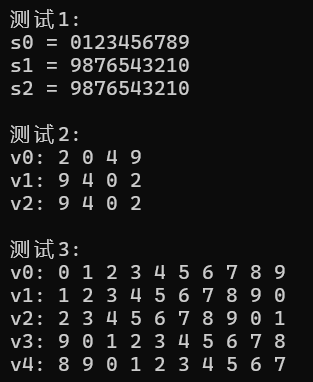
问题1reverse和reverse_copy的区别是前者原地反转容器中的元素顺序,对原容器是直接修改,而后者是将反转结果复制到新容器,不直接修改原容器。
问题2rotate算法的工作原理是通过循环移位的操作将元素序列进行重新排序,
问题3三个参数含义分别是 first,序列的起始位置;middle,新的起始位置;last,序列的结束位置
task2.cpp
点击查看代码
#include <iostream>
#include <vector>
#include <algorithm>
#include <numeric>
#include <iomanip>
#include <cstdlib>
#include <ctime>
// 模板函数声明
template<typename T>
void output(const T &c);
int generate_random_number();
void test1();
void test2();
int main() {
std::srand(std::time(0));
std::cout << "测试1: \n";
test1();
// 添加随机种子
std::cout << "\n测试2: \n";
test2();
}
// 输出容器对象c中的元素
template <typename T>
void output(const T &c) {
for(auto &i: c)
std::cout << i << ' ';
std::cout << '\n';
}
// 返回[0, 100]区间内的一个随机整数
int generate_random_number() {
return std::rand() % 101;
}
// 测试1:对容器类对象指定迭代器区间赋值、排序
void test1() {
using namespace std;
vector<int> v0(10); // 创建一个动态数组对象v0, 对象大小为10
generate(v0.begin(), v0.end(), generate_random_number); // 生成随机数填充v0
cout << "v0: "; output(v0);
vector<int> v1{v0};
sort(v1.begin(), v1.end()); // 对整个vector排序
cout << "v1: "; output(v1);
vector<int> v2{v0};
sort(v2.begin()+1, v2.end()-1); // 只对中间部分排序,不包含首尾元素
cout << "v2: "; output(v2);
}
// 测试2:对容器类对象指定迭代器区间赋值、计算最大值/最小值/均值
void test2() {
using namespace std;
vector<int> v0(10);
generate(v0.begin(), v0.end(), generate_random_number);
cout << "v0: "; output(v0);
// 求最大值和最小值
auto min_iter = min_element(v0.begin(), v0.end());
auto max_iter = max_element(v0.begin(), v0.end());
cout << "最小值: " << *min_iter << endl;
cout << "最大值: " << *max_iter << endl;
// 同时求最大值和最小值
auto ans = minmax_element(v0.begin(), v0.end());
cout << "最小值: " << *(ans.first) << endl;
cout << "最大值: " << *(ans.second) << endl;
// 求平均值
double avg1 = accumulate(v0.begin(), v0.end(), 0.0) / v0.size();
cout << "均值: " << fixed << setprecision(2) << avg1 << endl;
sort(v0.begin(), v0.end());
double avg2 = accumulate(v0.begin()+1, v0.end()-1, 0.0) / (v0.size()-2);
cout << "去掉最大值、最小值之后,均值: " << avg2 << endl;
}
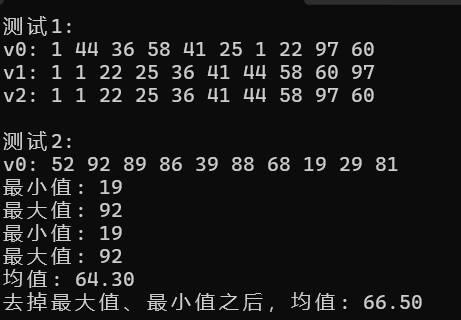
问题generate算法的作用对容器指定范围内的每个元素,调用生成器函数并将返回值赋给该元素
问题2minmax_element的优势在于只用遍历一次,时间复杂度小
问题3lambda替换后效果一致,在使用的时候现场创建临时的函数,能使代码简洁,使用更便捷。
task3.cpp
点击查看代码
#include <iostream>
#include <string>
#include <algorithm>
#include <cctype>
unsigned char func(unsigned char c);
void test1();
void test2();
int main() {
std::cout << "测试1: 字符串大小写转换\n";
test1();
std::cout << "\n测试2: 字符变换\n";
test2();
}
unsigned char func(unsigned char c) {
if(c == 'z')
return 'a';
if(c == 'Z')
return 'A';
if(std::isalpha(c))
return static_cast<unsigned char>(c+1);
return c;
}
void test1() {
std::string s1{"Hello World 2049!"};
std::cout << "s1 = " << s1 << '\n';
std::string s2;
for(auto c: s1)
s2 += std::tolower(c);
std::cout << "s2 = " << s2 << '\n';
std::string s3;
for(auto c: s1)
s3 += std::toupper(c);
std::cout << "s3 = " << s3 << '\n';
}
void test2() {
std::string s1{"I love cosmos!"};
std::cout << "s1 = " << s1 << '\n';
std::string s2(s1.size(), ' ');
std::transform(s1.begin(), s1.end(),
s2.begin(),
func);
}
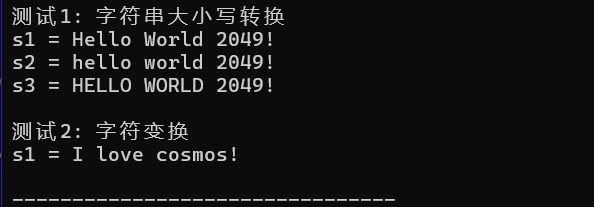
问题1func的功能是将字母后移一位
问题2tolower:将字母转换到小写字母,toupper将字母转换为大写字母
问题3transform的四个参数意义分别是,s1.begin()输入序列的起始迭代器;s1.end()输入序列的结束迭代器;s2.begin()输出序列的起始迭代器;func用于每个元素的转换函数。
问题4参数修改影响,由原来输出存到s2,s1不做改变,改为直接对s1进行修改
task4.cpp
点击查看代码
#include <iostream>
#include <string>
#include <algorithm>
#include <cctype>
bool is_palindrome(const std::string &s);
bool is_palindrome_ignore_case(const std::string &s);
int main() {
using namespace std;
string s;
// 多组输入,直到按下Ctrl+z的编辑值
while(cin >> s) {
cout << boolalpha
<< "区分大小写:" << is_palindrome(s) << "\n"
<< "不区分大小写:" << is_palindrome_ignore_case(s) << "\n\n";
}
}
// 函数is_palindrome定义 - 区分大小写
bool is_palindrome(const std::string &s) {
int left = 0;
int right = s.length() - 1;
while (left < right) {
if (s[left] != s[right]) {
return false;
}
left++;
right--;
}
return true;
}
// 函数is_palindrome_ignore_case定义 - 不区分大小写
bool is_palindrome_ignore_case(const std::string &s) {
int left = 0;
int right = s.length() - 1;
while (left < right) {
if (std::tolower(s[left]) != std::tolower(s[right])) {
return false;
}
left++;
right--;
}
return true;
}
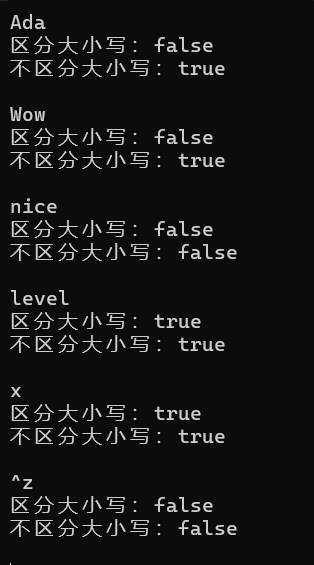
问题1如果希望测试包含空格输入,将while(cin >> s)改为while(getline(cin, s))
task5.cpp
点击查看代码
#include <iostream>
#include <string>
#include <algorithm>
std::string decInfo(int x, int n = 2);
int main() {
int x;
while(std::cin >> x) {
std::cout << "十进制: " << x << "\n"
<< "二进制: " << decInfo(x) << "\n"
<< "八进制: " << decInfo(x, 8) << "\n"
<< "十二进制: " << decInfo(x, 12) << "\n"
<< "十六进制: " << decInfo(x, 16) << "\n"
<< "三十二进制: " << decInfo(x, 32) << "\n\n";
}
}
std::string decInfo(int x, int n) {
if (x == 0) return "0";
std::string result = "";
bool isNegative = false;
if (x < 0) {
isNegative = true;
x = -x;
}
while (x > 0) {
int remainder = x % n;
x = x / n;
if (remainder < 10) {
result += '0' + remainder;
} else {
result += 'A' + (remainder - 10);
}
}
std::reverse(result.begin(), result.end());
if (isNegative) {
result = "-" + result;
}
return result;
}
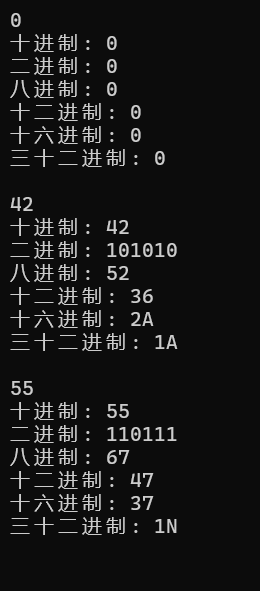
task6.cpp
点击查看代码
#include <iostream>
#include <string>
#include <algorithm>
int main() {
std::string alphabet = "abcdefghijklmnopqrstuvwxyz";
std::cout << alphabet << std::endl;
for (int shift = 1; shift <= 26; shift++) {
std::string shifted = alphabet;
for (char &c : shifted) {
c = std::toupper(c);
if (std::isalpha(c)) {
char base = 'A';
c = base + ((c - base + shift) % 26);
}
}
std::cout << shift << shifted << std::endl;
}
return 0;
}
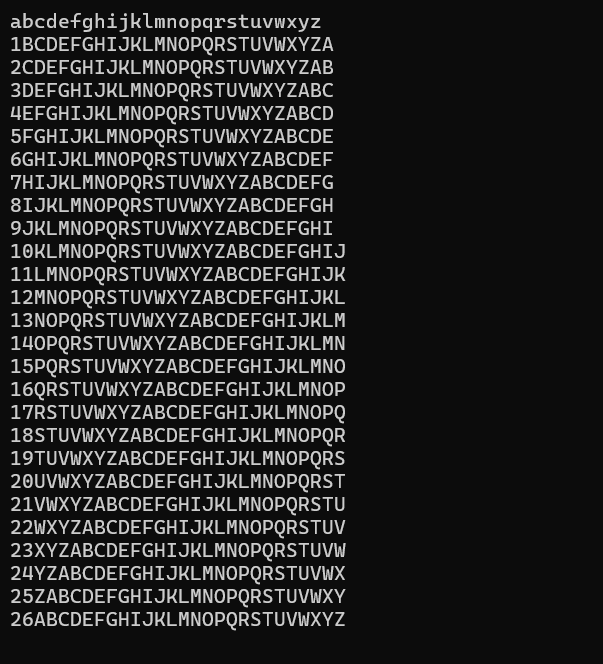
task7.cpp
点击查看代码
#include <iostream>
#include <cstdlib>
#include <ctime>
#include <iomanip>
int main() {
srand(time(0));
int correctCount = 0;
for (int i = 0; i < 10; i++) {
int num1 = rand() % 10 + 1;
int num2 = rand() % 10 + 1;
int operation = rand() % 4;
int correctAnswer, userAnswer;
switch (operation) {
case 0:
std::cout << num1 << " + " << num2 << " = ";
correctAnswer = num1 + num2;
break;
case 1:
if (num1 < num2) {
int temp = num1;
num1 = num2;
num2 = temp;
}
std::cout << num1 << " - " << num2 << " = ";
correctAnswer = num1 - num2;
break;
case 2:
std::cout << num1 << " * " << num2 << " = ";
correctAnswer = num1 * num2;
break;
case 3:
while (num1 % num2 != 0) {
num2 = rand() % 10 + 1;
}
std::cout << num1 << " / " << num2 << " = ";
correctAnswer = num1 / num2;
break;
}
std::cin >> userAnswer;
if (userAnswer == correctAnswer) {
correctCount++;
}
}
double accuracy = (correctCount / 10.0) * 100;
std::cout << "正确率:" << std::fixed << std::setprecision(2) << accuracy << "%" << std::endl;
return 0;
}
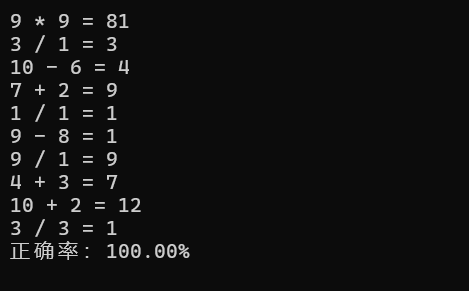



 浙公网安备 33010602011771号
浙公网安备 33010602011771号